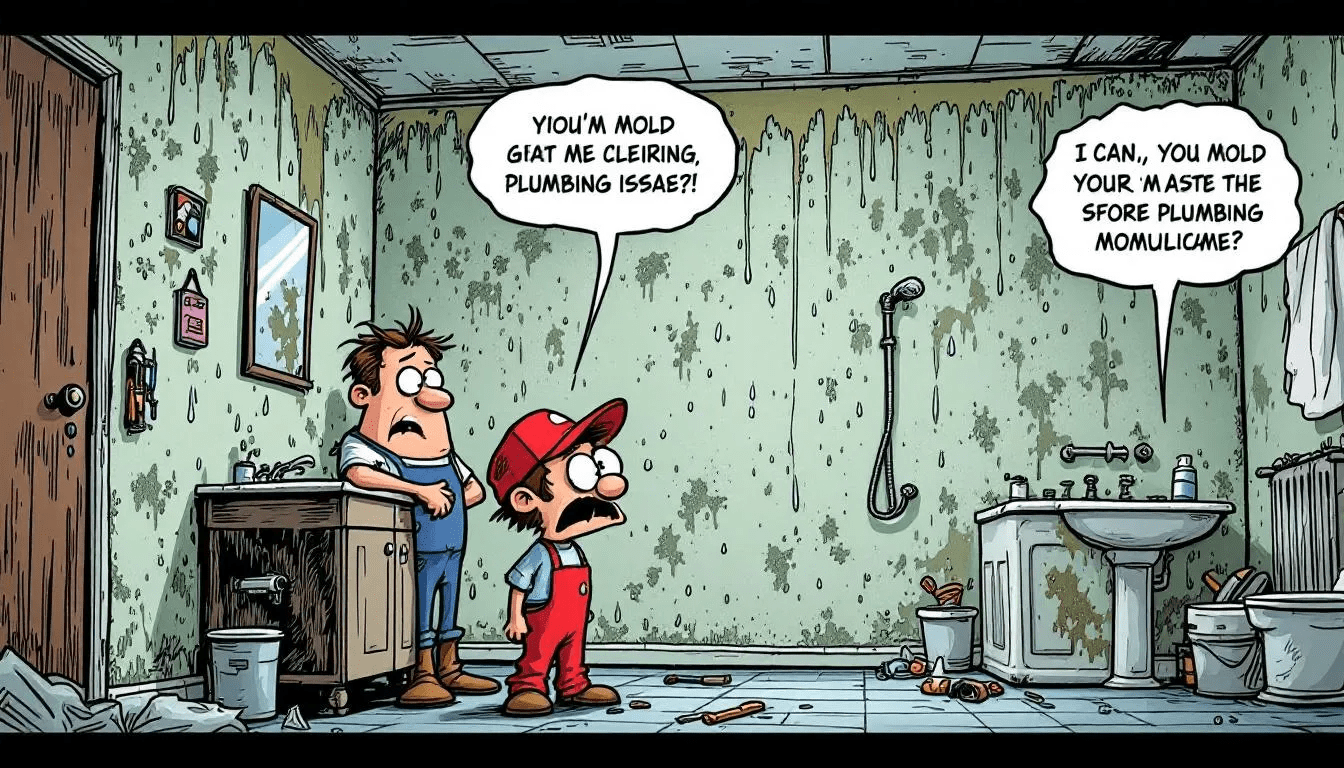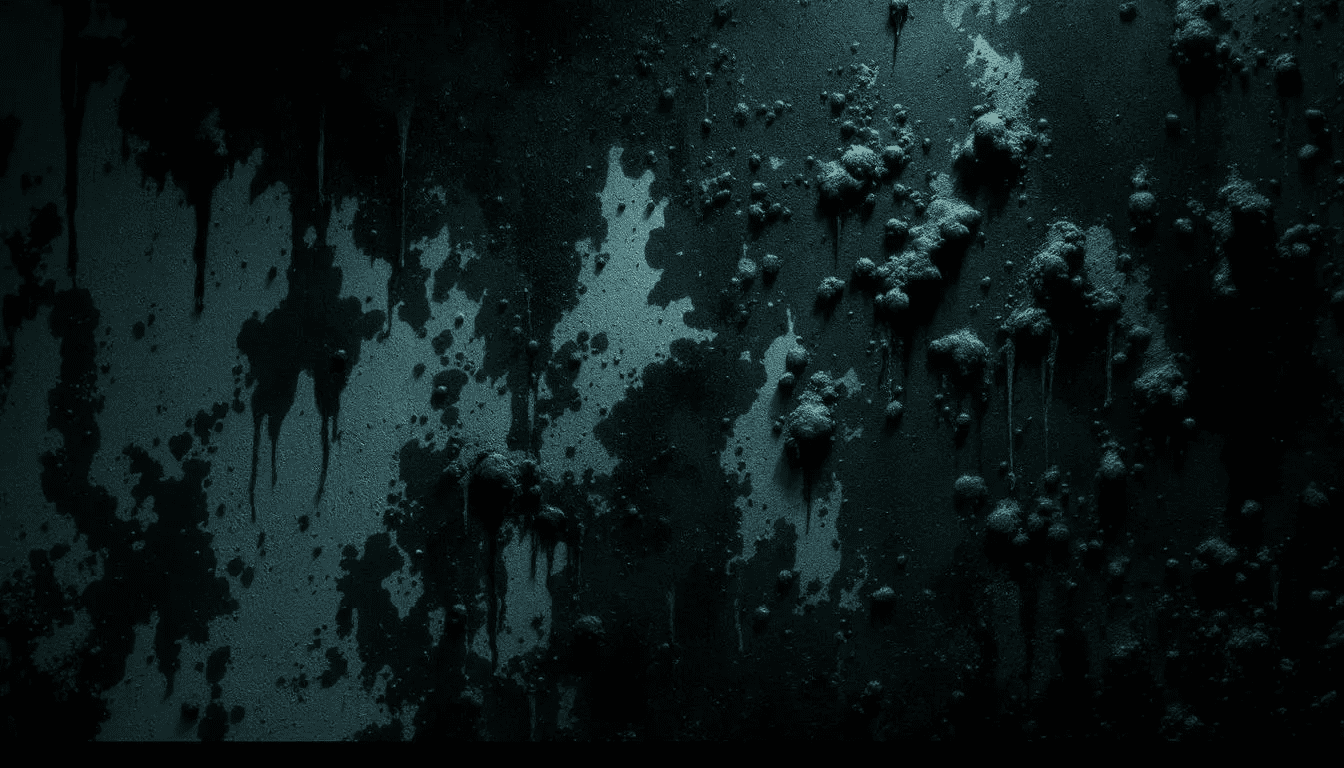Is mold in your bathroom a recurring issue? If so, it might be your plumbing’s fault. Leaky pipes, slow drains, and toilet base leaks can create the perfect environment for mold growth. This article will detail how these plumbing problems contribute to mold in the bathroom; it might be your plumbing’s fault and offer tips to fix them.
Key Takeaways
Leaky plumbing and insufficient ventilation are the primary causes of mold growth in bathrooms, underscoring the importance of regular plumbing inspections and effective moisture control.
Common signs of mold include musty odors, visible spots, and peeling paint, which should be addressed immediately to prevent health issues and structural damage.
Utilizing mold-resistant materials and proper ventilation strategies, such as exhaust fans, can significantly reduce the risk of mold and create a healthier bathroom environment.
Plumbing Issues That Cause Mold in Bathrooms
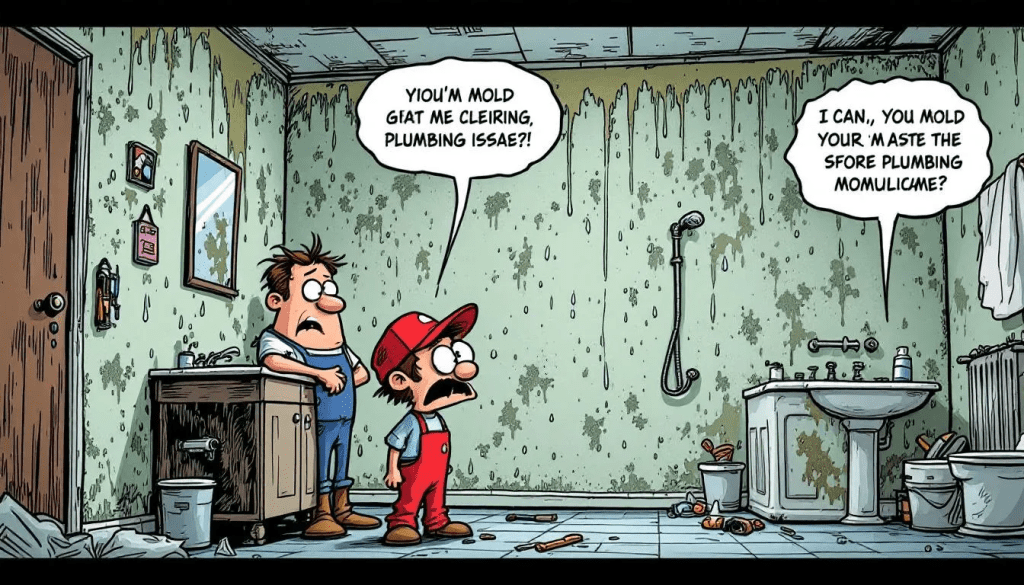
Mold thrives in damp and humid environments, making bathrooms a prime location for mold growth. The plumbing system in your bathroom, with its constant flow of water, can often be the source of excess moisture that leads to mold problems. Plumbing issues such as leaky pipes, slow drains, and toilet base leaks are common culprits that create conditions ideal for mold and mildew to flourish. Mold can also damage building materials such as drywall, insulation, and plumbing components, leading to costly repairs.
Understanding the connection between plumbing issues and mold growth is the first step in preventing mold problems. Mold requires both moisture and a food source, such as organic matter found around pipes and fixtures, to grow. Here are the main types of plumbing problems that can lead to mold in your bathroom: leaky pipes and fixtures, slow drains and stagnant water, and toilet base and seal leaks.
Leaky Pipes and Fixtures
Leaky pipes and fixtures are a significant source of moisture buildup in bathrooms, often leading to mold problems. Dust and dirt can accumulate around pipes and plumbing fixtures, trapping moisture and creating an environment where mold can thrive. Concealed leaks, even minor ones, can cause substantial mold issues over time. Discoloration or peeling paint on surfaces may suggest excess moisture and potential mold growth.
Water leaks, including a leaking faucet, often cause dark spots on bathroom walls, indicating mold development. Professional plumbers utilize advanced tools like infrared cameras to find hidden leaks without causing damage. Regular inspections and timely repairs by reputable plumbing services can prevent hidden leaks, leaking faucets, and the mold problems they cause.
Slow Drains and Stagnant Water
Slow drains cause water to collect, creating wet spots that are perfect for mold growth. The use of hot water during showers can increase humidity and condensation, further contributing to mold risk. Clogged drains and blocked sewer lines create stagnant water, which is an ideal breeding ground for mold and mildew. If clogged drains are left untreated, they can lead to fungal growth due to stagnant water where mold grows. Slow drains can also sometimes cause minor flooding, increasing the risk of hidden moisture and mold growth.
Promptly addressing drainage issues reduces excess moisture and prevents mold growth. Regularly cleaning drains, addressing clogs, and using drain screens can help prevent mold from taking hold in your bathroom.
Toilet Base and Seal Leaks
Leaking around the toilet base creates a damp environment conducive to mold formation. These leaks often go unnoticed until the telltale signs of mold appear on bathroom walls and floors. Water leaking beneath the toilet can damage the floor and create hidden areas for mold to grow. Regularly inspecting and maintaining toilet seals can prevent leaks and mold growth.
If you notice any water leaking from the base of your toilet, it’s crucial to address it immediately to prevent further damage and mold proliferation.
The Role of Ventilation in Preventing Mold
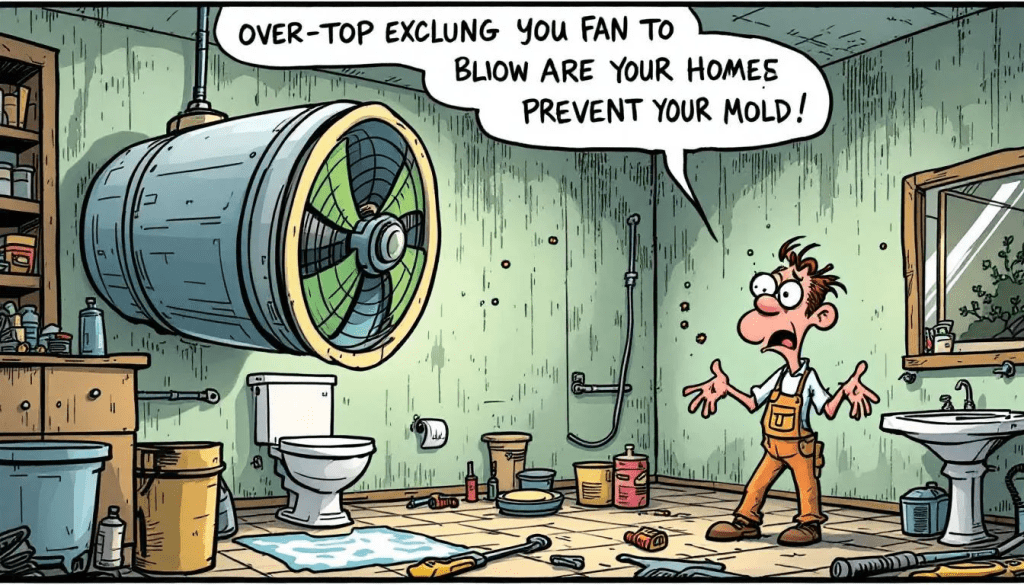
Proper ventilation is crucial in preventing mold growth in bathrooms, as it helps prevent moisture from settling on surfaces, including the ceiling. Key points include:
Ventilation helps remove excess moisture, which is key to preventing the damp conditions that favor mold growth.
Warm, humid conditions promote mold growth, making uncontrolled humidity a significant risk factor.
Managing temperature through heating and ventilation options, such as installing windows or upgrading systems, can greatly assist in moisture control. Air conditioning can also help control indoor humidity and prevent condensation.
Here’s how inadequate bathroom ventilation and the effective use of exhaust fans help prevent mold.
Inadequate Bathroom Ventilation
Poor airflow causes moisture accumulation, even in bathrooms with well-maintained plumbing systems. Poor ventilation can lead to persistent moisture, creating an environment conducive to mold proliferation. High humidity levels promote mold growth.
Using fans to increase airflow helps manage humidity in bathrooms, preventing persistent moisture and mold proliferation.
Effective Use of Exhaust Fans
Exhaust fans should be turned on during showers to help eliminate moisture effectively. It is advisable to run the exhaust fan for at least 30 minutes after showering to further reduce humidity.
Exhaust fans maintain low humidity levels, effectively preventing mold growth in bathrooms. Consistent use of a bathroom exhaust fan can significantly lower the risk of mold growth by maintaining a drier bathroom environment.
Common Signs of Mold in Your Bathroom
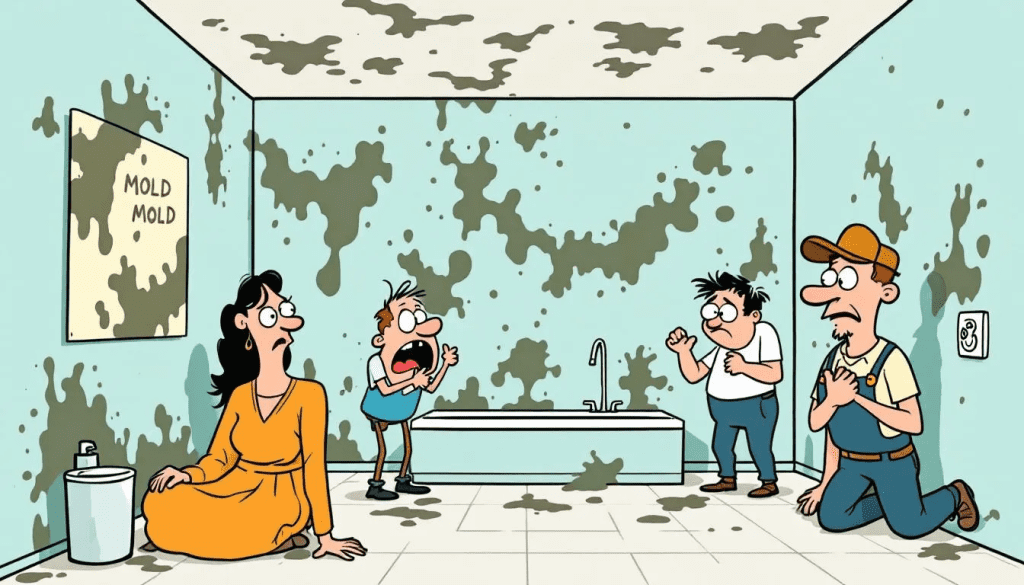
Recognizing common first signs of mold in your bathroom is crucial for early detection and prevention. Visible signs of mold include small patches on surfaces, often found between grout, along caulked edges, and around the toilet base. Concealed signs of mold can stem from tiny leaks that may go unnoticed until substantial growth occurs.
Regular checks for moisture buildup around pipes and fixtures can help prevent hidden mold from developing. Here are the specific signs to watch for:
Musty odors
Visible mold
Peeling paint
Dark spots
Noticing these symptoms early can help you address a mold problem before it worsens.
To keep your bathroom mold-free, perform regular checks for moisture and leaks. After any water incident, pay special attention to baseboards and drywall to ensure thorough drying and prevent mold.
Musty Odors and Visible Mold
A musty odor when using water often indicates mold in plumbing systems. Persistent musty smells in bathrooms can indicate mold issues. Mold can often be seen accumulating in areas like sinks, toilets, and around drainpipes.
Common areas for visible mold buildup in plumbing include pipes, joints, plumbing fixtures, showers, tub and sink drains, and toilets.
Peeling Paint and Dark Spots
Peeling paint and dark spots on bathroom walls and ceilings indicate moisture buildup and potential mold growth. Visible signs like peeling paint and dark spots often suggest that there is excess moisture trapped in the area. Common plumbing issues, such as leaks around toilet bases and seals, can lead to the moisture buildup indicated by these signs.
Ignoring peeling paint and dark spots can result in mold growth, posing health risks and potential property damage.
Health Risks Associated with Bathroom Mold
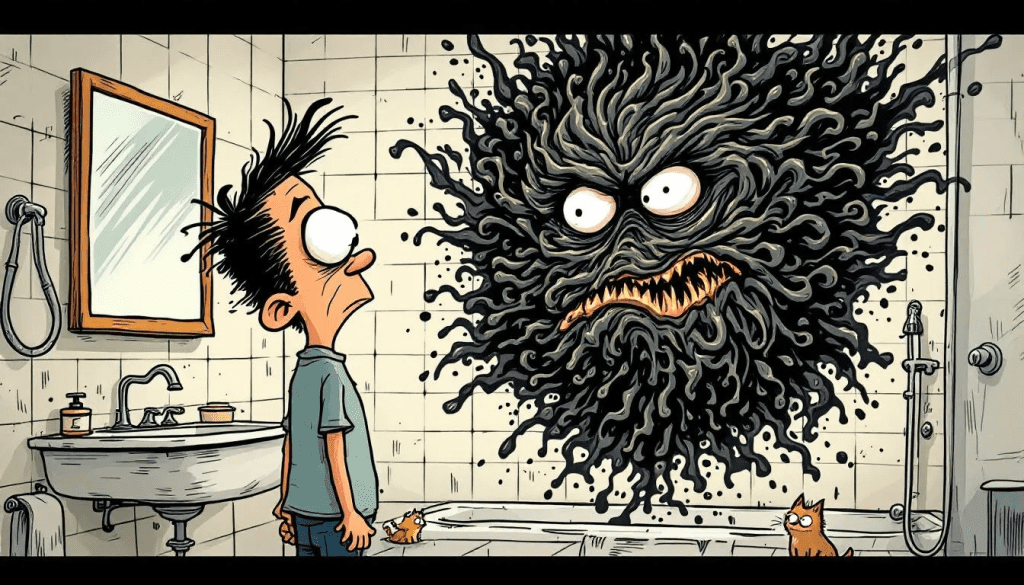
Exposure to mold can lead to various health concerns, particularly for individuals with underlying health conditions. Prolonged exposure to bathroom mold can lead to serious respiratory issues, notably exacerbating asthma symptoms. Certain populations, including children, the elderly, and those with respiratory or immune system disorders, are particularly at risk from mold exposure.
Let’s explore the specific health risks associated with mold exposure, focusing on allergies, respiratory issues, and long-term health consequences.
Allergies and Respiratory Issues
Mold can trigger allergic reactions, causing symptoms like sneezing, coughing, and nasal congestion. Individuals with asthma may experience exacerbated symptoms when exposed to mold.
Individuals with asthma or other respiratory issues are more likely to suffer severe effects from mold exposure.
Long-Term Health Consequences
Extended exposure to mold can lead to:
Chronic respiratory conditions
Worsening of existing chronic respiratory conditions
Ongoing health problems
Lasting damage to lung function and overall respiratory health
Mold exposure poses serious health risks, especially to the respiratory system due to mold spores.
Preventative Measures to Keep Mold at Bay
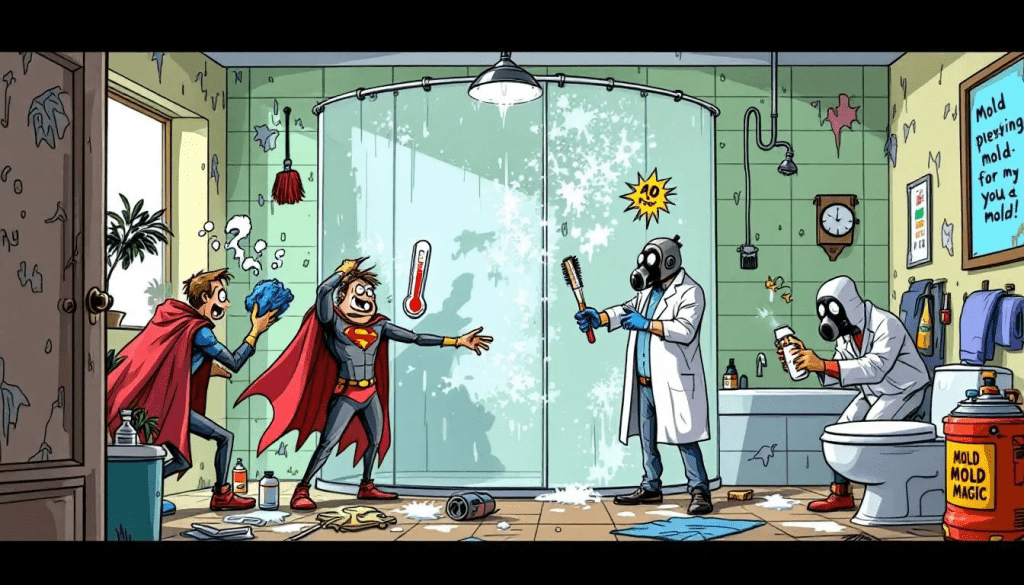
Prompt action to fix leaks can prevent extensive structural damage and mold infestations. Protecting your house from water damage and mold requires a comprehensive approach, including professional plumbing services and moisture control. Homeowners should:
Routinely inspect plumbing systems to identify leaks before they escalate.
Remove standing water immediately as it creates an ideal environment for mold growth.
Address blocked drains to prevent water accumulation, which fosters conditions that promote mold growth.
It is also important to inspect walls for hidden leaks that could lead to mold and structural issues.
Effective ventilation reduces humidity, making it less favorable for mold and mildew growth. Here’s why regular plumbing inspections and moisture control strategies are important.
Regular Plumbing Inspections
Regular plumbing inspections detect and fix leaks before they cause mold problems. During plumbing checks, inspect:
Pipes
Faucets
Bathroom sink (check for leaks and moisture buildup)
Connections
Signs of moisture buildup
Hidden leaks are a concern for mold growth as they create a breeding ground for spores. Be aware of unexpected spikes in the water bill, as they can indicate unseen leaks.
Regular cleaning of drains can help prevent mold smells and maintain moisture control. Regular drain cleaning and plumbing inspections provide peace of mind and help maintain a mold-free environment.
Moisture Control Strategies
Using dehumidifiers in damp areas can significantly lower indoor humidity levels in a humid environment. Ensuring proper ventilation when cooking or showering helps mitigate moisture buildup. Effective ventilation, such as running exhaust fans during and after showers, reduces humidity and prevents mold growth.
Quick Response to Water Leaks
Homeowners should take action immediately if they notice plumbing problems that can cause mold. A sudden increase in water bills may indicate hidden leaks that require immediate attention. Promptly drying wet areas within 24-48 hours is crucial to prevent mold growth.
Here are the immediate actions for leak detection and the importance of professional plumbing services.
Immediate Actions for Leak Detection
To manage water leaks and moisture effectively:
Address leaks immediately, and clean up water spills thoroughly.
Call a plumber to check for leaks if you notice standing water in the bathroom.
Monitor baseboards, drywall, and other porous materials for moisture after a water incident.
Have a plumber inspect for concealed leaks if suspected.
Have a certified plumber inspect the plumbing system if there are recurring mold odors. If cleaning drains does not resolve the problem, call a plumber to snake the drain or use a camera.
After cleaning up water spills, ensure the areas are completely dry using dehumidifiers or fans.
Professional Plumbing Services
Contact a professional for thorough mold removal services. Plumbers use tools like moisture meters or thermal imaging to detect leaks without damaging walls.
Professional plumbing services detect and fix all hidden leaks, preventing future mold problems.
Mold-Resistant Solutions for Bathrooms
Mold-resistant materials are essential in preventing mold growth in bathrooms, particularly in high-humidity areas. Examples of mold-resistant materials include:
Mold-resistant paint
Waterproof sealant
Antimicrobial shower curtains
Water-resistant sealers
Properly sealing around the bathtub is important to prevent water leakage and mold growth. Applying water-resistant sealers to grout lines also helps block moisture absorption and create a mold-resistant environment.
Waterproof treatments are crucial for protecting porous surfaces from moisture, which can lead to mold growth if untreated on the surface.
Using mold-resistant materials and waterproof treatments helps maintain a cleaner, healthier bathroom, minimizing mold issues. Here are the benefits of mold-resistant paint and caulking, as well as waterproof barriers and treatments.
Mold-Resistant Paint and Caulking
Mold-resistant paints have the following features:
Contain antimicrobial additives that inhibit mold growth on surfaces.
May include mildew-resistant additives to enhance mold-resisting properties.
Are specifically designed for high-humidity areas such as bathrooms to prevent mold growth.
Mold-resistant caulking around sinks, bathtubs, and other plumbing fixtures helps prevent mold and mildew buildup, keeping your bathroom mold-free.
Waterproof Barriers and Treatments
Waterproof barriers are designed to stop moisture from penetrating surfaces, which is essential for preventing mold growth. Waterproof treatments create a barrier that prevents moisture from penetrating surfaces. Applying waterproof sealants to bathroom walls, floors, and around plumbing fixtures can significantly reduce the risk of water damage and mold growth.
Additionally, using antimicrobial shower curtains and water-resistant sealers can further protect your bathroom from becoming a breeding ground for mold.
Summary
In summary, addressing plumbing issues promptly and maintaining proper ventilation are crucial steps in preventing mold growth in your bathroom. Regular plumbing inspections, moisture control strategies, and the use of mold-resistant materials can help keep mold at bay. Recognizing the signs of mold early and taking immediate action to fix leaks can prevent extensive water damage and serious health risks. By implementing these preventative measures, you can ensure a cleaner, healthier bathroom environment. Remember, a mold-free bathroom is not just about aesthetics; it’s about protecting your health and home. Take action today to keep mold away!
Frequently Asked Questions
What plumbing issues commonly cause mold growth in bathrooms?
Leaky pipes and fixtures, slow drains, and toilet base leaks are common plumbing culprits behind mold growth in bathrooms. Addressing these issues promptly can help you maintain a healthy and mold-free environment!
How can I prevent mold growth in my bathroom?
To prevent mold growth in your bathroom, promptly fix any plumbing leaks, ensure proper ventilation, and consider using mold-resistant materials. Taking these steps will create a healthier space for you and your loved ones!
Why is proper ventilation important in preventing mold?
Proper ventilation is crucial for preventing mold by removing excess moisture and reducing damp conditions. By utilizing exhaust fans, especially in high-humidity areas, you can significantly lower humidity levels and keep your home mold-free!
What are the health risks associated with mold exposure in bathrooms?
Mold exposure in bathrooms can lead to serious health risks like allergic reactions and respiratory issues, especially for vulnerable individuals such as children and the elderly. Take action now to ensure your space is mold-free and protect your health!
What should I do if I discover a water leak in my bathroom?
Act quickly to clean up any spills and call a professional plumber to fix the leak. Using dehumidifiers or fans to dry the area will help prevent mold growth and keep your bathroom safe.

